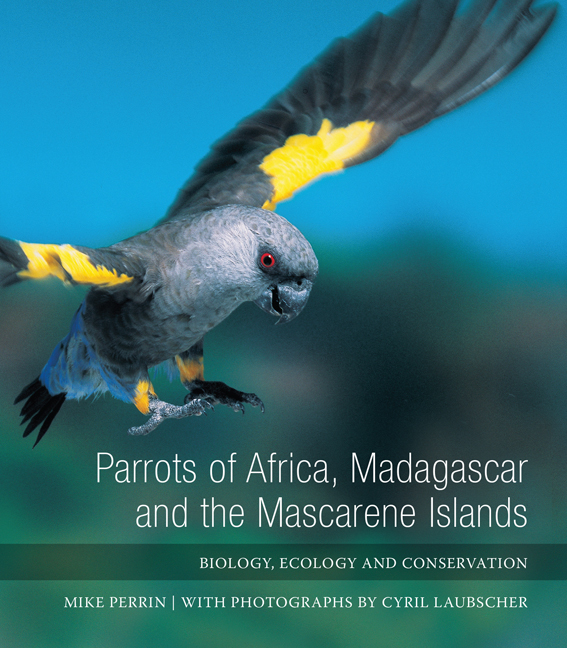Book contents
- Frontmatter
- Contents at a glance
- Contents
- Acknowledgements
- List of tables
- List of figures
- Abbreviations
- Chapter 1 Introduction
- Chapter 2 Conservation Biology
- Chapter 3 Systematics
- Chapter 4 Biogeography and Niche Separation
- Chapter 5 Intelligence, Communication and Behaviour
- Chapter 6 Breeding Biology
- Chapter 7 Diet and Metabolism
- Chapter 8 Case Study – The Cape Parrot
- Chapter 9 Trade in African parrots
- Chapter 10 African Parrot Conservation
- THE PARROT SPECIES OF AFRICA
- IUCN CATEGORIES
- Chapter 11 Long-Tailed and Fossil Parrots
- Chapter 12 True Parrots
- Chapter 13 Lovebirds
- Chapter 14 Field Techniques in Parrot Research
- Species lists
- Glossary
- Bibliography
- Index
Chapter 9 - Trade in African parrots
Published online by Cambridge University Press: 04 June 2019
- Frontmatter
- Contents at a glance
- Contents
- Acknowledgements
- List of tables
- List of figures
- Abbreviations
- Chapter 1 Introduction
- Chapter 2 Conservation Biology
- Chapter 3 Systematics
- Chapter 4 Biogeography and Niche Separation
- Chapter 5 Intelligence, Communication and Behaviour
- Chapter 6 Breeding Biology
- Chapter 7 Diet and Metabolism
- Chapter 8 Case Study – The Cape Parrot
- Chapter 9 Trade in African parrots
- Chapter 10 African Parrot Conservation
- THE PARROT SPECIES OF AFRICA
- IUCN CATEGORIES
- Chapter 11 Long-Tailed and Fossil Parrots
- Chapter 12 True Parrots
- Chapter 13 Lovebirds
- Chapter 14 Field Techniques in Parrot Research
- Species lists
- Glossary
- Bibliography
- Index
Summary
SUSTAINABLE HARVESTING
In developing African countries with growing populations and economic needs, effective land preservation is becoming increasingly difficult. Strategies that can integrate conservation and development in a sustainable manner (IUCN 1980; Reid 1989), such as extraction reserves where animal and plant products are harvested from primary forest, need careful consideration (Fearnside 1989; Peters et al. 1989).
Sustainability, the continued persistence and replenishment of a resource under utilisation – for example, populations of parrots – demands harvesting at a rate equivalent to the productivity of the population so that overall numbers remain more or less stable (Caughley 1977). Biologists working with endangered parrots (and other species) have applied the principles of sustained harvesting as last-resort efforts to build captive flocks by taking birds from wild populations, with minimal effects on the overall productivity of these populations (Snyder et al. 1987; Snyder & Snyder 1989).
African parrots, particularly African Grey Parrots and lovebirds, are harvested from the wild for the pet trade at alarming rates (Mulliken 1991). Their numbers have decreased in recent years owing to habitat destruction and over-exploitation. Legislation restricting imports to the USA and EU should start to counter this problem. African Grey Parrots and Cape Parrots nest in large trees in mature forests and forage in the crowns of the trees, mostly on fruits, berries and leaf buds. These forests are disappearing at a rate that explains local extinctions. The impact of habitat destruction is exacerbated by the collection of nestlings, during which the nest cavity in the trunk or the entire tree is cut down, leaving many cavities unusable for future nesting by parrots.
BIOLOGICAL KNOWLEDGE NEE DED FOR SUSTAINABLE HARVESTING
For the sustainable harvesting of a species population one needs to know the boundaries of such a population in terms of its numbers, resilience and reproductive rate, demographics and population trend, geographical distribution and mobility, genetic diversity and inbreeding depression, habitat limitations (including diet and nest sites), and the intensity and effects of predation and disease. This requires a great deal of field and some laboratory research over an extended period of time, owing to environmental perturbations such as forest degradation and climate change.
- Type
- Chapter
- Information
- Parrots of Africa, Madagascar and the Mascarene IslandsBiology, Ecology and Conservation, pp. 241 - 284Publisher: Wits University PressPrint publication year: 2012



